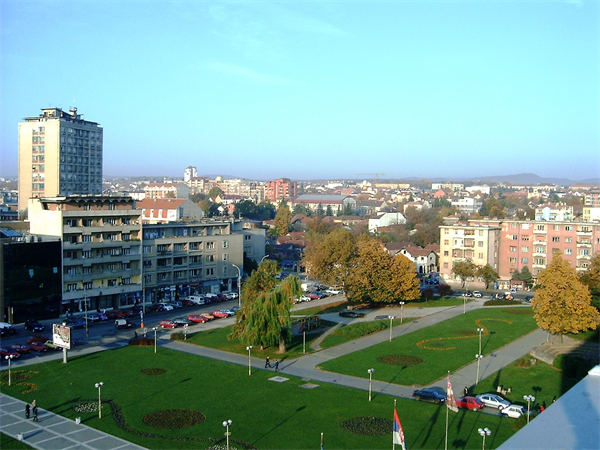- CURRENT LOCATION: HOME
- >> About Shaanxi
- >> Global Associations
- >> Sister Cities
- >>
- Xi'an
Kragujevac (Serbia)
2017-04-17 13:50:48 , Source : The Government Website of Shaanxi Province
Kragujevac is the fourth largest city of Serbia and the administrative center of the Šumadija District in central Serbia. It is situated on the banks of the Lepenica River. According to the official results of the 2011 census, the city administrative area has a population of 179,417 inhabitants.
Kragujevac was the first capital of modern Serbia (1818–41); the first constitution in the Balkans was proclaimed in the city in 1835. The city's first grammar school and printworks were both established in 1833, followed by the professional National theatre (1835), Military academy (1837) and the first full-fledged university in the newly independent Serbia (1838). Kragujevac was the site of a massacre by the Nazis (1941), in which 2,778 Serb men and boys were murdered. Contemporary Kragujevac is known for its munitions (Zastava Arms) and automobile industry (Fiat Automobili Srbija).
As an important university center, the University of Kragujevac was established on 21 May 1976, from departments of the University of Belgrade Faculty of Mechanical Engineering and Faculty of Economics, which began to work in late 1960s. The University of Kragujevac includes twelve schools, six located in Kragujevac with others located in Čačak, Kraljevo, Jagodina, Užice and Vrnjačka Banja. The city has two scientific research institutes: the Institute for Field Crops in Kragujevac and Fruit and Grape Research Institute in Čačak.
Climate
Kragujevac has temperate continental climate, characterized by relatively cold winters and hot summers. The coldest month is January and the warmest July. The months with the most rainfall are May and June, and months with the least rainfall are January, February and March. Winds most often blow from southwest and northwest, while they often blow from Southeast in January, February and March. The average number of snowy days is 34.
Economy
Kragujevac has been an important industrial and trading center of Serbia for more than two centuries, known for its automotive and firearms industries. The former state-owned Zastava Automobiles Company was purchased by Fiat in 2008, and renamed Fiat Serbia. Fiat was joined by partners Magneti Marelli (exhaust systems and control panels), Johnson Controls (car seats and interiors), Sigit (thermoplastic and rubber components) and HTL (wheels).
According to National Bank of Serbia, there were 30 commercial banks operating in Serbia in December 2016. One of these is Direktna banka, which has its headquarters in Kragujevac. Direktna banka has had a long tradition of operating in Central Serbia dating back to the second half of the 21st century It offers wide range of banking products, mostly loans, to business and households. The only owners of the bank are Andrej Jovanovic, one of the owners and CEO of Moji Brendovi, a holding company, and Bojan Milovanovic. In November 2016, Direktna banka bought 100% ownership stake in Findomestic banka Beograd.
The Kragujevac Fair was established in 2005 thanks to the project "Support to the development and promotion of regional economy through development of City Fair". It comprises 1,600 square metres (17,222 sq ft) of area dedicated to trade and exhibitions and 1,000 square metres (10,764 sq ft) of area for other activities (administration, Media center, restaurant etc.).
Education
There are 22 primary and 8 secondary schools in Kragujevac. There are also 3 special schools: School for hearing impaired children, Music school Dr Miloje Milojevic, and the Vukasin Markovic School (for children with disabilities).
The University of Kragujevac was established on 21 May 1976 although the first higher education institutions started with operations in 1960 as departments of the University of Belgrade. It is fourth largest university in Serbia and is organized in 12 faculties and two institutes which are spread over six cities (Kragujevac, Čačak, Kraljevo, Užice, Jagodina and Vrnjačka Banja) of the Central Serbia region which covers an area populated by 2,500,000 people. Around 16,000 students are currently enrolled at the university. It has around 1,350 employees out of which 900 is teaching and research staff.
The University Library in Kragujevac is of generally scientific character, and its primary users are university teaching staff and students. Its area is 1,500 square metres (16,000 square feet) and includes several storage rooms, reading area and University Gallery. The library takes care of around 100,000 copies of books, 2,500 doctoral and master thesis, 450 titles of domestic journals and 105 titles of foreign journals.

Government Organizations



Other Links

Copyright@www.shaanxi.gov.cn All Rights Reserved
Registration Number:陕ICP备10004160号
